The most common pests and diseases of peas, as well as effective methods of prevention and getting rid of them
Peas are a frost-resistant crop that does not require much effort when grown in a garden bed or on a windowsill. But even this plant often encounters various diseases and pests.
In this article, we will discuss the signs of pest infestation (with a photo), pea diseases and measures to combat them. We will also share with you tips on prevention methods.
The content of the article
Pea diseases
Consider the most popular diseases that summer residents may encounter when growing peas.
Fusarium root rot
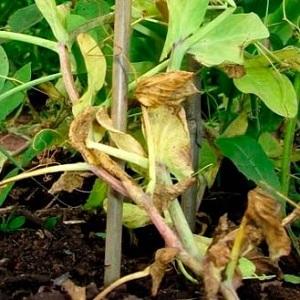 Fusarium root rot is a fungal disease. It is caused by fungi of the genus Fusarium. These fungi multiply and develop in the soil, therefore, basically, pea infection with Fusarium occurs precisely through the soil.
Fusarium root rot is a fungal disease. It is caused by fungi of the genus Fusarium. These fungi multiply and develop in the soil, therefore, basically, pea infection with Fusarium occurs precisely through the soil.
The disease occurs during prolonged cool weather and high humidity.
At the same time, plants are most affected by Fusarium root rot in hot and dry weather.
- Signs. Fusarium root rot primarily affects the pea root. First, the root and lower part of the stem turns brown, after which the whole plant gradually withers. The disease destroys the root system, it darkens and becomes loose. Sick peas can be easily removed from the ground.
- Treatment. At the first signs of fusarium root rot, crops must be treated with fungicides (for example, Kolosal Pro).
- Prevention. The main thing is to follow the rules of crop rotation. Peas cannot be returned to their previous planting site for 4-6 years. It is best to germinate the peas thoroughly before planting.
The soil must be worked deeply before planting. Disease can be avoided if the seeding time is followed correctly
Drinking root rot
Another type of root rot is drinking. It is caused by fungi of the genus Pythium. Drinking root rot is believed to promote the development of other types of root rot in the soil.
Drinking mushrooms are most active in early spring, when the soil has not yet warmed up. The mycelium develops most actively at temperatures from +6 to +10 degrees, and the development of the mushrooms themselves occurs at temperatures from +1 to + 30 ° C.
- Signs. Germinating seeds and plant roots simply rot. The areas affected by the disease become brown and soft. The plant withers.
- Treatment. Fungicides also help against drinking root rot (for example, "Homosil" - has a long-term therapeutic and prophylactic effect).
- Prevention... Soil care. When developing a garden, it is necessary to use phosphorus-potassium fertilizers. Also, use only high-quality, healthy, processed seeds for growing peas.
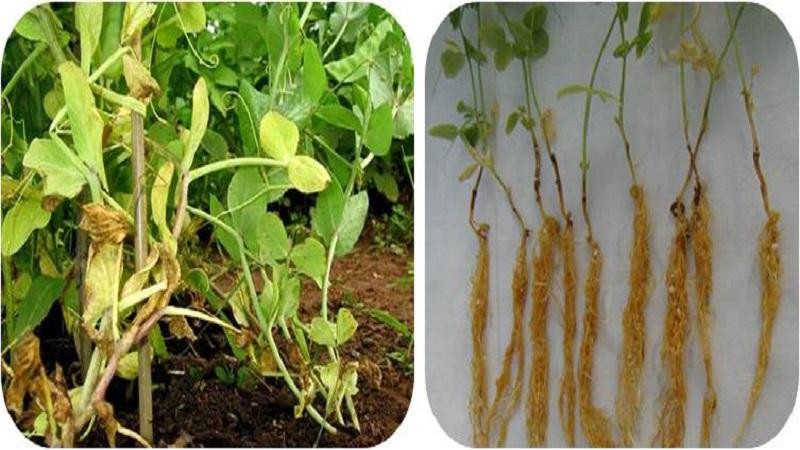
Gray rot
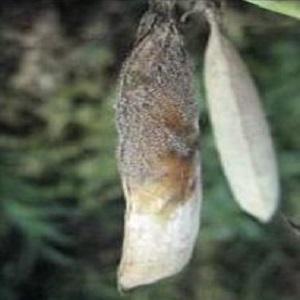 Gray rot peas causes the fungus Botrytis cinerea Pers. The disease develops with high air humidity and high rainfall.
Gray rot peas causes the fungus Botrytis cinerea Pers. The disease develops with high air humidity and high rainfall.
Infection occurs through the soil or when growing peas from previously infected seeds (in this case, the mycelium is stored directly in the grains).
- Signs. The most characteristic signs of gray mold infection of peas are a thick gray coating on the flowers and pods of the plant. The pods also turn brown towards the base and the affected areas increase in size.
- Treatment. For the treatment of peas from gray rot, the following fungicidal solutions are most often used: "Strobi", "Keeper", "Chistotsvet", "Discor" and others.
- Prevention. Correct crop rotation, control of aphids on plants. Water the garden in moderation.
White rot
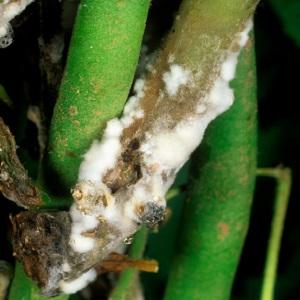 White rot of peas is caused by the mushroom Peronospora manshurica Sydow. Infection, like gray rot, occurs through an infected soil, or while maintaining the mycelium in the seeds.
White rot of peas is caused by the mushroom Peronospora manshurica Sydow. Infection, like gray rot, occurs through an infected soil, or while maintaining the mycelium in the seeds.
Favorable conditions for the development of white rot are coolness and high humidity.
- Signs. The affected areas of the plant first acquire a brown color, and then become covered with a white mycelium, similar to cotton wool. The plant withers and dies.
- Treatment. Recently, a biological product has appeared designed to disinfect the soil from many fungal diseases - "Trichoderma verde".
- Prevention. It is necessary to follow the rules of crop rotation, use fungicides for seed germination and soil cultivation, and also destroy plant residues with biological products.
Rust
Another fungal disease of legumes is rust. The spores of the dioecious fungus are carried by the wind and infect the peas when they hit them. The disease develops in warm and humid weather.
- Signs. Rust mainly affects the stem and leaves, less often the pods. Brown pustules appear on the affected areas. With a strong infection, the leaves turn completely yellow and gradually dry out.
- Treatment. Rust is treated with approved fungicides. For example, already known to us "Strobi" and "Homosilom".
- Prevention. Early sowing will help to avoid rust, using pea seed early ripening varieties, weed control and plant treatment with fungicides.
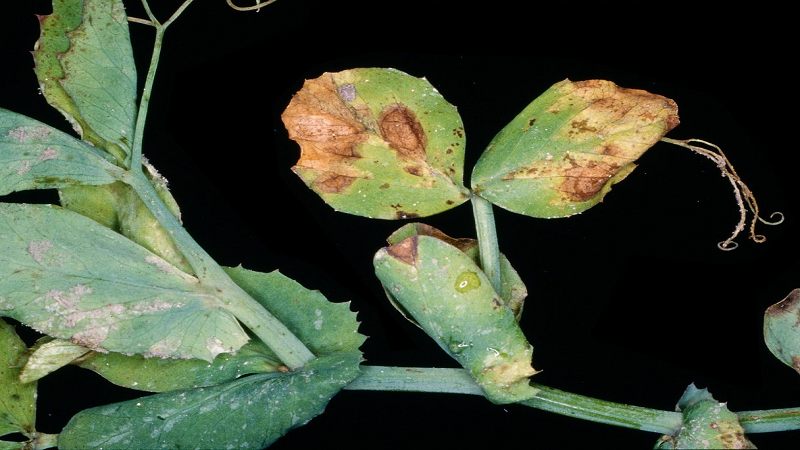
Powdery mildew
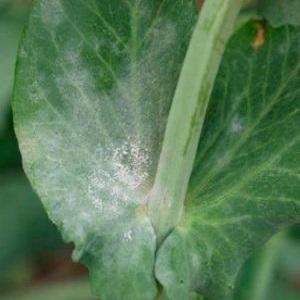 Powdery mildew also belongs to fungal diseases of peas. It develops at an average temperature of 18 to 21 degrees Celsius, 70-80% humidity and little rainfall.
Powdery mildew also belongs to fungal diseases of peas. It develops at an average temperature of 18 to 21 degrees Celsius, 70-80% humidity and little rainfall.
- Signs. The first signs of powdery mildew appear on the lower leaves and stalk of peas with a barely noticeable white coating, similar to a cobweb. With the development of the disease, the number of affected areas increases, plaque becomes noticeable, and the leaves and stem turn yellow and dry out.
- Treatment. To treat peas from powdery mildew, use permitted fungicides or 1% Bordeaux liquid.
- Prevention. Compliance with the rules of crop rotation, deep digging of the soil. It is imperative to destroy plant debris in the fall, on which fungal spores can winter.
Downy mildew
Downy mildew, or downy mildew, develops at high humidity and dense sowing.
The disease is transmitted through contaminated seeds and plant debris.
- Signs. Peronosporosis appears as a gray-purple bloom on the underside of the leaves. Over time, these spots turn brown and the affected leaves dry out and fall off.
- Treatment. With the first signs of downy mildew, the peas are sprayed with 1% Bordeaux mixture. Powdered green leaves with lime.
- Prevention. Use for planting only healthy seeds of early ripening varieties, early sowing and timely weeding.
Ascochitosis
Pea ascochitis is transmitted in the same way. This disease develops with a large amount of rainfall and an average temperature of 20-25 degrees.
- Signs. Ascochitosis affects the entire plant from the bottom up. It manifests itself in the form of dark brown spots, on which small black dots form over time. Ascochitis often leads to root decay.
- Treatment. For treatment, pea seedlings are sprayed with 1% Bordeaux liquid or 0.4% copper oxychloride.
- Prevention. Prevention of ascochitis consists in the early sowing period, the choice of early maturing plant varieties. It is worth digging up the soil deeply and following the rules of crop rotation.
Bacterial spot
Bacterial spot, or bacteriosis of peas, spreads through infected seeds and plant debris.
It manifests itself in warm and humid weather.
- Signs. Spots of different shapes and sizes appear on the affected areas. An oily border forms around the spots. Over time, the spots can merge together, affecting larger areas of the plant.
- Treatment. Use of fungicides (e.g. Phyton-27).
- Prevention. Permitted fungicides are also suitable for the prevention of bacteriosis. It is worth choosing seeds of pea varieties resistant to bacteriosis for planting, plant only healthy peas.
Deforming mosaic
Deforming mosaic is a viral disease of peas.
Pea aphids carry the virus to healthy plants.
- Signs. The disease begins with the appearance of light green spots on the leaves, which gradually become transparent. Affected leaves become speckled, wrinkled, and curly. Beans are deformed in the same way.
- Treatment. At the first signs of deforming mosaic, all pea bushes must be treated with a solution of karbofos (75 g per 10 l of water). Heavily infested plants must be removed immediately along with the soil.
- Prevention. Killing pea aphids, sowing early, using healthy seeds, disinfecting garden tool blades.
Anthracnose
Anthracnose is a fungal disease that develops in cool, rainy and windy weather.
Infection occurs through seeds and plant debris.
- Signs. Brown spots form on leaves, stems and beans. In the center of the spots are orange and red pads with bristles (fungal spores).
- Treatment. Fungicides - "GreenCure", "Strobi", "Homosil", etc.
- Prevention. Crop rotation and deep plowing. Infected plant residues must be destroyed immediately.
Pea pests
In addition to fungi, viruses and bacteria, there are many pests among the enemies of peas.
Pea weevil
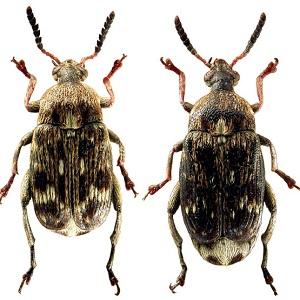 The pea weevil, or bruchus, is a black beetle with reddish-gray hairs. The caryopsis arrives on peas during flowering and feeds on pollen.
The pea weevil, or bruchus, is a black beetle with reddish-gray hairs. The caryopsis arrives on peas during flowering and feeds on pollen.
The larva, after hatching from the egg, penetrates the pea and feeds on it.
Deliverance. To get rid of peas from caryopsis, gardeners use insecticides.
Prevention. Early sowing of early ripening peas. Careful selection of healthy grains for growing (infected peas float in a 3% sodium chloride solution).
Pea moth
The pea moth is a butterfly that lays eggs during pea flowering. The caterpillar hatches, penetrates the pod and feeds on the peas.
Deliverance. You can get rid of the moth by treating the bush with tobacco, ash or celandine powder. Insecticide "Bi-58" or "Lannat".
Prevention. Early sowing of early ripening pea varieties, deep digging of the soil. Loosening for the destruction of moth pupae.
Pea aphid
Aphids are a bright green beetle that migrates to peas at the end of May. Sucks sap from leaves, stems, flowers and beans.
Deliverance. Spraying peas with the drug "Fury", "Iskra", "Fastak" and other insecticides. You can harvest the crop no earlier than 10 days after processing.
Prevention. Early sowing of early ripening pea varieties. Destruction of wild legumes.
Pea scoop
The pea scoop is another butterfly, its striped caterpillar feeds on plant leaves, primarily peas.
Deliverance. Treatment of plants with insecticides: "Bi-58", "Karate Zeon", "Pirineks".
Prevention. Cultivation, autumn plowing (digging the soil in the fall with the removal of weeds and the introduction of fertilizers), weed control.
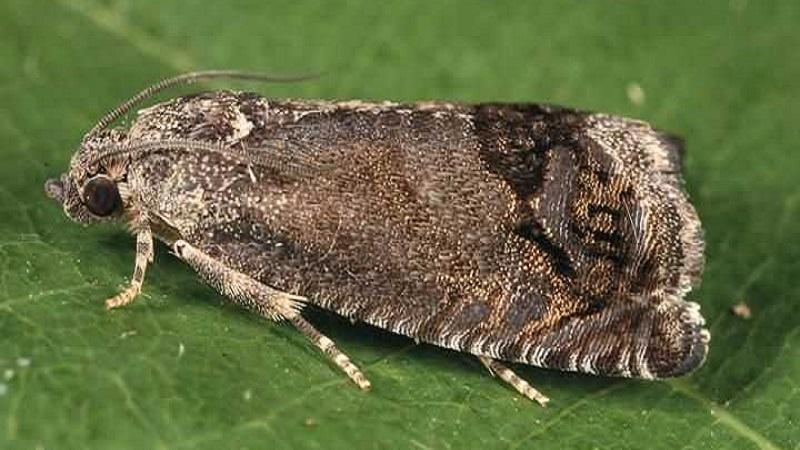
Nodule weevil
The nodule weevil is a soil-dwelling beetle that is active in warm weather. Its larvae feed on pea roots, and the beetle itself eats seedlings in spring.
Deliverance. Pollination of seedlings with karbofos. They also use tobacco dust, ash, dust from plant residues of marigolds.
Prevention. Sowing peas early in well developed soil. Removing pea crops from other legumes.
Bean moth
Moth is a butterfly. Its caterpillars infect beans and harm pea seeds.
Deliverance. Insecticides and biological pesticides will help in the fight against moths.
Prevention. Early sowing of early maturing peas. Deep digging of soil. Planting away from forest belts with white and yellow acacia.
Umbelliferous beetle
Umbelliferae is a small green insect with transparent wings. Its larvae damage various plants, including peas.
Deliverance. The infected plant must be sprayed with tobacco broth.
Prevention. Correct crop rotation, fungicide treatment, deep plowing, growing peas only from healthy seeds.
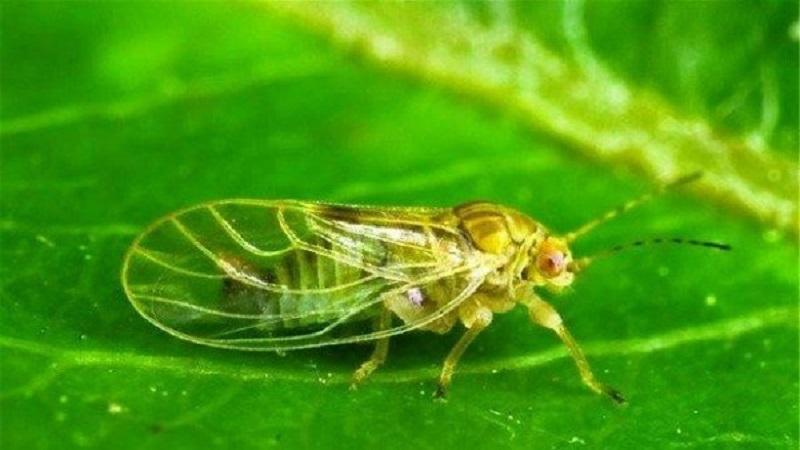
Worms
The worms in the pea beans are the larvae of the pea weevil. Fighting them is no different from fighting an adult insect.
General recommendations for protecting peas from pests
As you can see, early sowing, the use of early ripening varieties and deep digging of the soil help in protection from pests and diseases of peas.
It is worth paying attention to the seeds - their correct selection will help to avoid damage to peas by several types of pests and diseases at once.
Important! Re-planting peas in the same place is possible only after 4-6 years.
Gardeners often do not know how to treat peas from diseases and pests. In the article, we have listed the main effective tools. Try using special solutions, fertilizers, as well as alternative methods of prevention to combat pests and diseases of peas.
Conclusion
Peas are often damaged by pests and diseases. However, when choosing the right variety, correct selection of seeds, timely planting with the correct cultures and due leaving you can grow healthy and tasty harvest... It can be used for both food and re-planting.
Do not miss the timing of sowing seeds, be sure to select and disinfect them before planting, observe the growth of plants and take control measures as warning signs appear. Have a good harvest of peas!